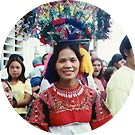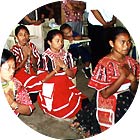


Telefax: (0632) 633.7442. Email: cartwheelinc@pacific.net.ph
|
THE LUMADS Cartwheel Foundation Inc. has been working hand in hand with the community of Miarayon since 1998. This is Cartwheel's first project area. The Miarayon community located in Talakag, Bukidnon, in the Philippine island of Mindanao is inhabited primarily by indigenous people of Tala-Andig (meaning "oppressed") origin. They are referred to as native Lumads. |
|
This exciting journey of working with the community to become more educated and economically stable has contributed immensely to our knowledge of our heritage, roots, environment, and of our own selves. What you find below is some information on warm, gentle natives who have remained solid reminders to many of us, about what is truly Filipino. WHO
ARE THE LUMADS? |

THE
LUMADS OF MINDANAO
In
Mindanao, the Lumads comprise 18 ethno-linguistic groups. In the 1970
census, their combined population in Mindanao and Sulu had been reduced
to five percent. Mindanao has 14 of the country's 20 poorest provinces;
hence the low literacy rates in the region. This poverty has attracted
assistance or "development programs" mostly in the form of resettlement
of displace lumads. But this displacement was sometimes caused by the
Lumad's loss of their ancestral lands to logging concessions, mining industry,
plantations, agri-business, military operations, political and economic
marginalisation and the like-aggravating the hardships and misery that
began during the Spanish occupations.
 Since
titling of lands was started by the Spanish government, the Lumads began
losing their ancestral domain.
Since
titling of lands was started by the Spanish government, the Lumads began
losing their ancestral domain.
The Lumads believe that land is given by God for them to till and to share its bounties. There is no individual ownership and their being residents of the place entitles them to it. This customary law, however, does not apply to a "modern, civilized world". As a result, most Lumads moved deeper into the mountains and forests, they were turned into "impoverished squatters in their own land".
Next came the resettlement programs of the American government in the early 1900s until 1948 and the homestead program after World War II. Mindanao became the migration site for the landless people of Luzon and Visayas. Again, the illiterate Lumads did not have land titles to keep their lands. They lost what they had tilled and moved farther, or stayed for an uncertain future.
THE LUMADS OF BUKIDNON AND INTEGRATION
The
Lumads of Bukidnon reacted to his migration by staying or migrating into
the mountains and forests. Those who remained were influenced by the migration
and started adopting food-production techniques, whereas those who left
and had little exposure to or contact with modern culture or civilization
were able to preserve their tradition. In the 1950s, through scholarships,
resettlement and financial aid, integration efforts were instituted by
the government. Integration has brought about three types of Lumads: fully
integrated, partially integrated, and unintegrated.
 These
folks live on ancestral, untitled land, which is the main and oftentimes
the sole source of their dailyt sustenance. Part of Cartwheel's
initiatives in the area is to assist in the acquisition of land
titles for the Lumad's properties, to avoid capitalist exploitation.
Their other needs include access to quality education, medical and
health care, and knowledge on proper nutrition, sanitation and environment
conservation.
These
folks live on ancestral, untitled land, which is the main and oftentimes
the sole source of their dailyt sustenance. Part of Cartwheel's
initiatives in the area is to assist in the acquisition of land
titles for the Lumad's properties, to avoid capitalist exploitation.
Their other needs include access to quality education, medical and
health care, and knowledge on proper nutrition, sanitation and environment
conservation.